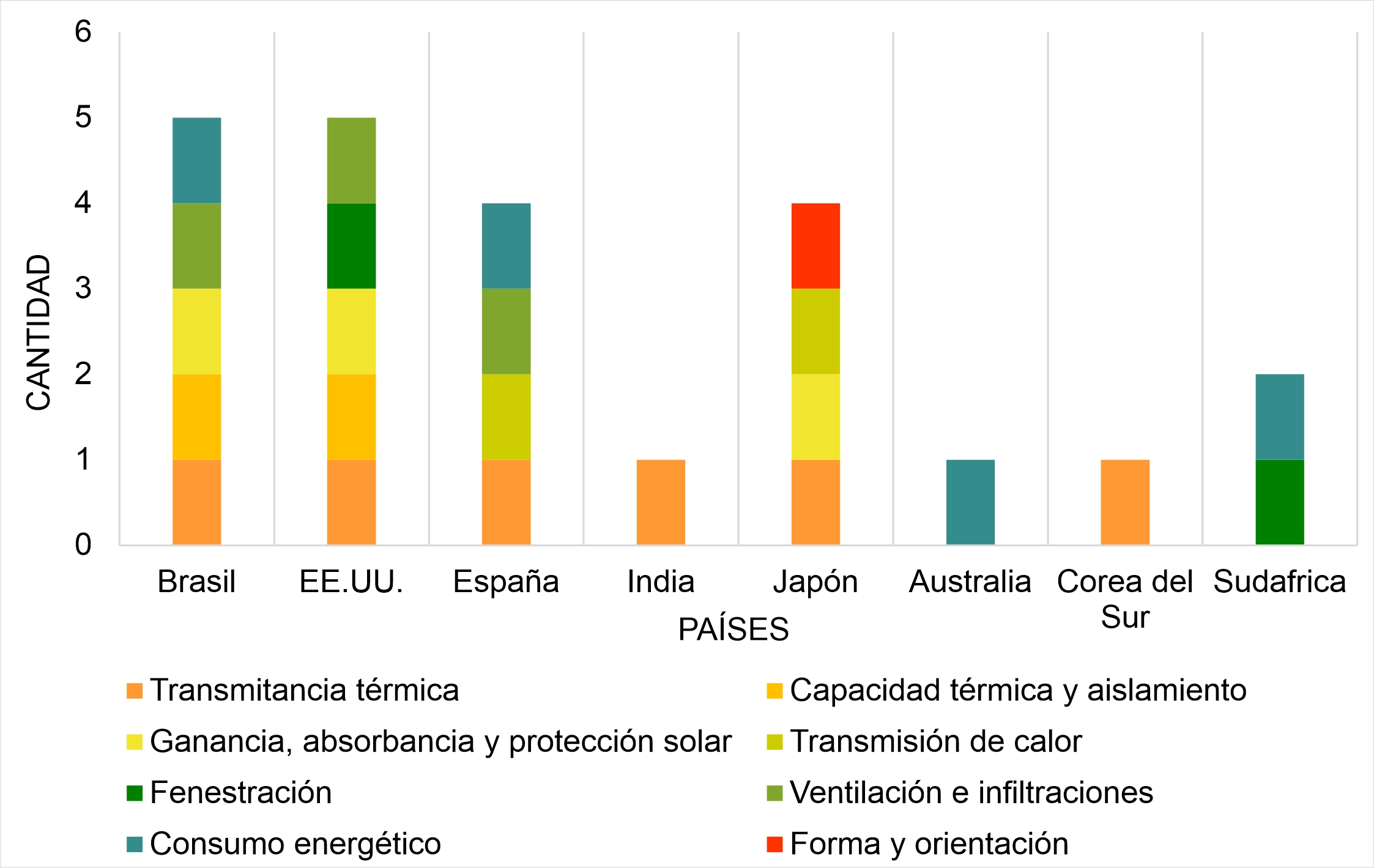International regulations on building energy efficiency
Comparative analysis of architectural envelope evaluations
DOI:
https://doi.org/10.18861/ania.2023.13.1.3369Keywords:
Comparative analysis, Envelope, Energy efficiency regulations, Evaluation methodologiesAbstract
The elements that make up the architectural envelope in contact with the outside represent a conclusive factor in energy consumption and have a direct influence on the energy demand of the building. For this reason, the objective of the work is to analyze the different ways of energetically evaluating the architectural envelope in regulations at a global level and detecting its representative components. The research methodology is a theoretical-descriptive study, based on a systematic mapping that enables comparison between regulations. Next, the analysis variables and the type of information contained in them are obtained. It follows that the most important aspects to consider in the design and evaluation of the envelope are the climatic zone present in 34% of the regulations, the glaze-opaque relationship, and the thermal transmittance, present in 41% and 93% respectively. When comparing the scope of Argentine regulations with international examples, it is concluded that it is necessary to reinforce the studies and regulations related to the glaze-opaque relationship.
Downloads
References
Ahmad, T., y Zhang, D. (2020). A critical review of comparative global historical energy consumption and future demand: The story told so far. Energy Reports, 6, 1973–1991. https://doi.org/10.1016/J.EGYR.2020.07.020
Alwetaishi, M. (2019). Impact of glazing to wall ratio in various climatic regions: A case study. Journal of King Saud University - Engineering Sciences, 31(1), 6–18. https://doi.org/10.1016/j.jksues.2017.03.001
Andersen, M., Martini, I., y Díscoli, C. (2019). Clasificación y evaluación del sector residencial orientada a la aplicación masiva de estrategias de reciclado edilicio. AREA, 25(1), 1–24.
Ascione, F., Bianco, N., Maria Mauro, G., y Napolitano, D. F. (2019). Building envelope design: Multi-objective optimization to minimize energy consumption, global cost and thermal discomfort. Application to different Italian climatic zones. Energy, 174, 359–374. https://doi.org/10.1016/j.energy.2019.02.182
Asdrubali, F., y Desideri, U. (2018). Handbook of Energy Efficiency in Buildings. A Life Cycle Approach. In Butterworth-Heinemann 2018 (Ed.), Handbook of Energy Efficiency in Buildings: A Life Cycle Approach. Elsevier. https://doi.org/10.1016/B978-0-12-812817-6.00002-4
Barbaresi, A., Bovo, M., y Torreggiani, D. (2020). The dual influence of the envelope on the thermal performance of conditioned and unconditioned buildings. Sustainable Cities and Society, 61. https://doi.org/10.1016/j.scs.2020.102298
Bensehla, S., Lazri, Y., y Mansouri, K. (2019). The analysis process in bioclimatic architectural design. International Seminar Sustainable Cities and Local Development, 01–07. https://www.researchgate.net/publication/344378409
BID. (2017). Eficiencia energética en América Latina y el Caribe: avances y oportunidades.
Blázquez, T., Ferrari, S., Suárez, R., y Sendra, J. J. (2019). Adaptive approach-based assessment of a heritage residential complex in southern Spain for improving comfort and energy efficiency through passive strategies: A study based on a monitored flat. Energy, 181, 504–520. https://doi.org/10.1016/j.energy.2019.05.160
Boutet, M. L., y Hernández, A. L. (2022). Validación de propuestas de optimización ambiental de un jardín de infantes de tipología compacta, en clima muy cálido-húmedo. Hábitat Sustentable, 12(1), 24–43. https://doi.org/10.22320/07190700.2022.12.01.02
Chiesa, G., Acquaviva, A., Grosso, M., Bottaccioli, L., Floridia, M., Pristeri, E., y Sanna, E. M. (2019). Parametric optimization of window-to-wall ratio for passive buildings adopting a scripting methodology to dynamic-energy simulation. Sustainability (Switzerland), 11(11). https://doi.org/10.3390/su11113078
Czajkowski, J. D., y Gómez, A. F. (2002). Diseño bioclimático y economía energética edilicia. Fundamentos y métodos: Vol. I (Universidad Nacional de La Plata, Ed.).
Foroushani, S., Bernhardt, R., y Bernhardt, M. (2022). On the use of the reference building approach in modern building energy codes. Energy and Buildings, 256. https://doi.org/10.1016/j.enbuild.2021.111726
Huynh, A., Dias Barkokebas, R., Al-Hussein, M., Cruz-Noguez, C., Chen, Y., y Donn, M. (2021). Energy-Efficiency Requirements for Residential Building Envelopes in Cold-Climate Regions. Atmosphere, 12(405). https://doi.org/10.3390/atmos12030405
IRAM. (2001). Norma IRAM 11604. Aislamiento térmico de edificios. Verificación de sus condiciones higrotérmicas. Ahorro de energía en calefacción. Coeficiente volumétrico G de pérdidas de calor. Cálculo y valores límites.
IRAM. (2002a). Norma IRAM 11601. Aislamiento térmico de edificios. Métodos de cálculo.
IRAM. (2002b). Norma IRAM 11605. Acondicionamiento térmico de edificios. Condiciones de habitabilidad en edificios. Valores máximos de transmitancia térmica en cerramientos opacos.
IRAM. (2012). Norma IRAM 11603. Acondicionamiento térmico de edificios.
Jezierski, W., Sadowska, B., y Pawłowski, K. (2021). Impact of changes in the required thermal insulation of building envelope on energy demand, heating costs, emissions, and temperature in buildings. Energies, 14(1). https://doi.org/10.3390/en14010056
LETI. (2020). Climate Emergency Design Guide. https://www.leti.uk/cedg
Secretaría de agenda urbana y vivienda. (2020). ERESEE 2020. Estrategia a largo plazo para la rehabilitación energética en el sector de la edificación española. https://energy.ec.europa.eu/system/files/2020-06/es_ltrs_2020_0.pdf
Secretaría de vivienda. (2020). Vivienda Sustentable. Manual de ejecución.
Subramanian, S., Bastian, H., Hoffmeister, A., Jennings, B., Tolentino, C., Vaidyanathan, S., y Nadel, S. (2022). 2022 International Energy Efficiency Scorecard. www.aceee.org/research-report/i2201
Tushar, W., Lan, L., Withanage, C., En, H., Sng, K., Yuen, C., Wood, K. L., y Kumar, T. (2020). Exploiting design thinking to improve energy efficiency of buildings. Energy, 197, 117–141. https://doi.org/10.1016/j.energy.2020.117141
United Nations. (2022). The Sustainable Development Goals Report 2022. https://unstats.un.org/sdgs/report/2022/The-Sustainable-Development-Goals-Report-2022.pdf
United Nations Development Programme. (2021). Types of climate and climate zones. https://climate-box.com/textbooks/the-problem-of-climate-change/2-2-effects-on-plants-and-animals/
Wong, L., y Krüger, E. (2017). Comparing energy efficiency labeling systems in the EU and Brazil: Implications, challenges, barriers and opportunities. Energy Policy, 109, 310–323. https://doi.org/10.1016/j.enpol.2017.07.005
Yusuf, A. (2020). Evaluation of bioclimatic principles in design of office building in hot-dry climate region of Nigeria. International Journal of Engineering Research and Technology, 9(4), 820–826. www.nachi.org

Downloads
Published
How to Cite
Issue
Section
License
Copyright (c) 2022 Celina Michaux, Graciela Melisa Viegas, Irene Alicia Blasco Lucas

This work is licensed under a Creative Commons Attribution 4.0 International License.
The journal and its contents are licensed under the Creative Commons - Attribution 4.0 International License (CC BY 4.0). It is possible to copy, communicate and publicly distribute its content as long as the individual authors and the name of this publication are cited, as well as the publishing institution (Universidad ORT Uruguay).

